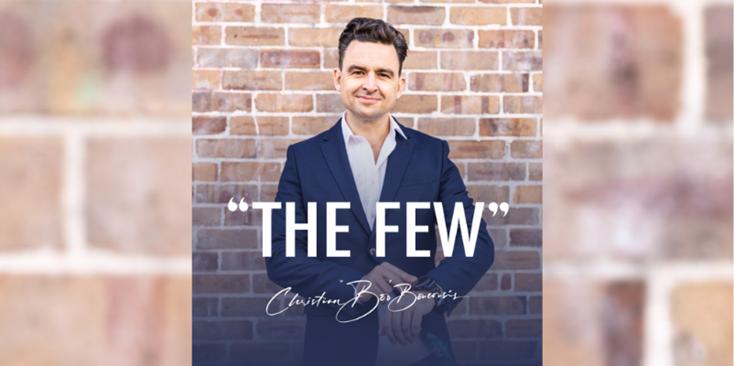How to turn your meetings into growth accelerators
5 min read.
Learning how to debrief properly can transform your meeting culture, keep your employer brand aligned and create transformative strategic results that will accelerate growth, argues former fighter pilot and business consultant Christian 'Boo' Boucousis...
How did your last meeting at work go? What did you get out of it?
Was it a free-flowing exchange of brilliant ideas that, when implemented, will bring about transformational change to your organisation? Were there high-fives and back slaps all-round at the end of it?
It’s likely to be a no, right? It was probably dominated by the usual suspects, and the usual suspect thinking, and maybe you had a good idea, but no-one listened, or you were too nervous about voicing it. And, in any case, how many of the ideas will be implemented anyway?
Chances are the next meeting will be the same.
But stand by your beds, maybe it’s not a meeting but a debrief that you need?
“Feedback without action is opinion. Feedback with action is a debrief,” explains Christian ‘Boo’ Boucousis, former fighter pilot, CEO of the Afterburner business consultancy and host of the business leadership podcast, The Few.
Afterburner is about real fighter pilots telling the story of what they do every day - operating at the best of their ability as an individual, as a team, and as teams of teams.
“We have a methodology that's called Flawless Execution, which is about getting what you want as quickly and with as little amount of effort as possible,” adds Boo.
“Afterburn in an aeroplane accelerates the aeroplane. In terms of what we do as a business, we help accelerate organisations and individuals towards their goal.”
What makes a leader
The Few podcast which he hosts puts him in front of business leaders who explain what set them on their path, and examines the qualities needed to be a successful leader. It’s no surprise there are a few common threads - purpose being one of the main drivers.
“Most people aren't in it for money, they're in it for something that means something to them or will mean something to other people, and the byproduct of it is commercial success.
“The second is their ability to get things done every day, just small things and growing them. The third is that most of them have experienced adversity, because when we ask the question, ‘what would you have told yourself back when you're a teenager about your journey?’, often they say, ‘that you'll be okay, and maybe enjoy the journey a little bit?’.
“To be a great leader or a highly successful person requires sacrifice on the way and a lot of discomfort and, lastly, curiosity. Always have an open mind to everything. No expectation that the way we do things today is the right way. There could be another way to do it. And so that openness to learning something new, is also a common thing. And if you have those four traits, everything else looks after itself.”
The value of a debrief
Applying the methodology of pilot training to business means using effective debriefing to learn lessons along the way and incrementally add to skills and experience, rather than adopting a sink or swim approach which can seem overwhelming to many and counter-productive to achieving strategic objectives.
“That's what debriefing is. It's about trying something new but basing it on something real that you've already done. And if you think of your comfort zone as a bubble, you're just constantly pushing it out. And it's getting bigger and bigger and bigger, and you’re getting comfortable with more things, rather than what most people think of, which is jumping outside that hole where everything that's safe and familiar no longer exists. The model that we built to train fighter pilots, is to just gradually expand what they're comfortable with, without breaking them.
“The more you practice the same thing and make it routine in your life every day, the better you are at it. You free your brain up for more creative thought. That could be something as simple as the habits that you have running a business. If every time you do your accounts, it's like the first time you've ever done it, then you haven't systemised it enough. The numbers will change but the system in which you process accounts should remain the same.”
Feedback is about identifying problems; debriefing is about identifying problems but doing something about it.
“There are four steps to a debrief. The first step is what am I trying to achieve here? Or, put simply, what's the objective? The second one is, where am I today? The third question is why am I there? Why is that my result if I want to be over there? And then the final step in the process is action. What can I do right now? And that's important. It's an action not an idea, and not a plan. People that are good at debriefing are great at circling back to the action that is doable.
“And the thing about debriefing is it's not just adding one per cent today, it’s one per cent cumulative every day. So, the fact you've learned one per cent more yesterday means we build on it the next day, and the next day.
“Fighter pilots need a very steep learning curve. We need to learn faster and faster as we go. And there's an expectation that we can stay on that learning curve. So, to become a fighter pilot, you demonstrate your ability to stay on a steep learning curve and they will push you and push you until you come off it.
“The irony is it's easy, and conceptually, it's very simple, but you would be amazed at how incredibly difficult it is for people to ask those four questions. And the reason is this. Firstly, they don't know what they're trying to achieve. So, they don't know what their objectives are. Secondly, because they're not clear about what their role is on the team, they don't really know which results apply to them. So, we tend to live in collective results, not individual results.
Nameless and rankless
To put an end to a culture of pointless meetings that don’t achieve the right outcomes, it is necessary to create a different type of forum for discussion, he argues.
“To be effective at debriefing as a leader, you've got to empower everyone to debrief as an individual. We have a culture called ‘nameless and rankless’, which means in debriefing you put all the politics aside, all the jockeying for position inside the company, all the personality clashes, and in this room, in the debrief, everyone's equal, and it's all about what's right for the objective, not who's right.”
For your employer brand, regular debriefs will act as a navigational aid to ensure that your strategy is still relevant, still aligned with your objectives and has kept up with any changes in your structure or culture. It might lead to a refresh of your EB.
“Every organisation has different DNA. If you create culture as a leader and you know what you stand for, you allow the people that you're recruiting to make a decision about you. Not one in ambiguity.
“I think what's really important with the way that we engage is to clearly articulate what ‘good’ looks like for us as a community and as a business and understand what good looks like for our employees. It's not always going to match. So, it's impossible to have the 100% solution and it's going to ebb and it’s going to flow and the beauty about incorporating these debriefs is that as it ebbs and flows, as it changes, as opinions evolve, we keep pace with that because, we are always checking in and acting on it every single day.”
Boo’s clues
Follow these tips to improve your leadership and team management…
Find time to debrief
People say they don't debrief because they don't have time and the really easy answer to that is you don't have time because you don't debrief. If you start there, everything else looks after itself. So, if you start by debriefing and your first question is, ‘what's the point?’. ‘Do we all understand why we're here?’ Do we know why we're doing this product launch? Do we know why we're meeting this client? Do we know why we're about to embark upon this project? And because we ask why, that's when people come up with another question. Is it a good idea? So, step number one, start with a debrief.
Be nameless and rankless
Cultivate a radically transparent culture which is nameless and rankless. A forum for everyone to say anything as long as it's not personal. Radical transparency means you must have a clear objective that's measurable, and to have a conversation around it. It can't just be your opinion.
Be selfless
Always be in service. I just watched Arnold Schwarzenegger’s latest documentary and when he ended his best advice was to be useful wherever you can be useful. Serve someone. Do something for someone else.
Never give up
No matter what you choose to do in life, no matter where you choose to get to, it is always hard, even when attempting small things. And you might just quit the day before it happens. You might want to be an actor and for three years you're doing the whole circuit and then no one's ever told you to quit, they just say you’re not right for this role. And then on Thursday, you say stuff it, I'm never going to be an actor. And on Friday, the perfect role is sitting there. That's the irony of the universe. The universe rewards, persistence. Persistence is the best form of planning, because no matter what your plan is, you’ve got to keep going until you get there.


